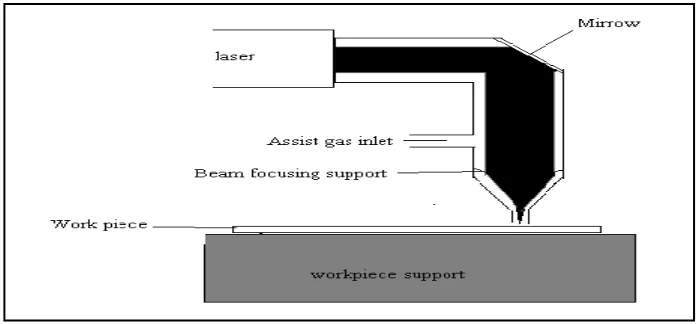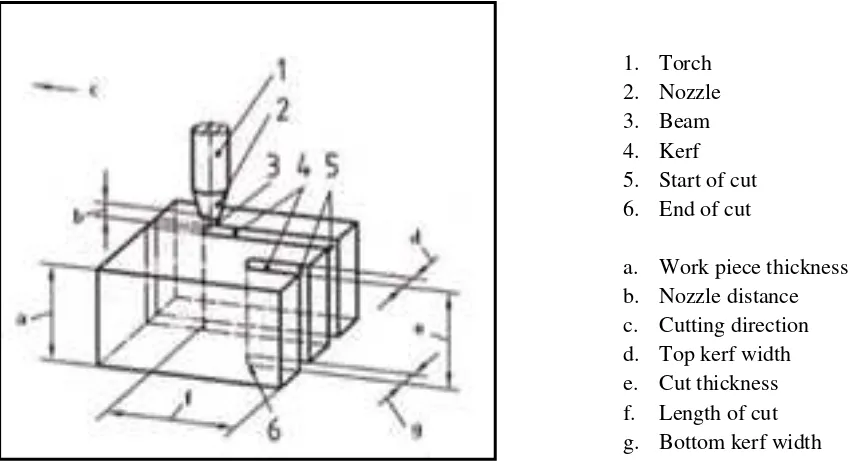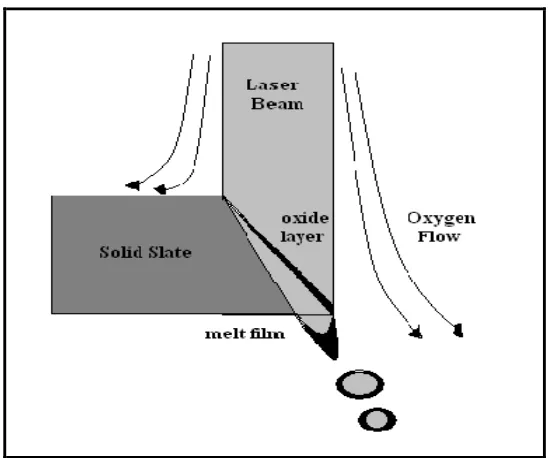CO
2LASER CUTTING OF CERAMIC TILES
MUHAMMAD QUSYAIRI BIN ABDUL RAHMAN
UNIVERSITI TEKNIKAL MALAYSIA MELAKA
CO
2LASER CUTTING OF CERAMIC TILES
This report submitted in accordance with requirement of the Universiti Teknikal Malaysia Melaka (UTeM) for the Bachelor Degree of Manufacturing Engineering
(Manufacturing Process) with Honours.
by
MUHAMMAD QUSYAIRI BIN ABDUL RAHMAN
FACULTY OF MANUFACTURING ENGINEERING
oval
UTeM Library (Pind.1/2005)
UNIVERSITI TEKNIKAL MALAYSIA MELAKA (UTeM)
BORANG PENGESAHAN STATUS TESIS*
JUDUL: CO2 LASER CUTTING OF CERAMIC TILES
SESI PENGAJIAN: 2008/2009
Saya MUHAMMAD QUSYAIRI BIN ABDUL RAHMAN
mengaku membenarkan tesis (PSM/Sarjana/Doktor Falsafah) ini disimpan di Perpustakaan Universiti Teknikal Malaysia Melaka (UTeM) dengan syarat-syarat kegunaan seperti berikut:
1. Tesis adalah hak milik Universiti Teknikal Malaysia Melaka.
2. Perpustakaan Universiti Teknikal Malaysia Melaka dibenarkan membuat salinan untuk tujuan pengajian sahaja.
3. Perpustakaan dibenarkan membuat salinan tesis ini sebagai bahan pertukaran antara institusi pengajian tinggi. atau kepentingan Malaysia yang termaktub di dalam AKTA RAHSIA RASMI 1972)
* Tesis dimaksudkan sebagai tesis bagi Ijazah Doktor Falsafah dan Sarjana secara penyelidikan, atau disertasi bagi pengajian secara kerja kursus dan penyelidikan, atau Laporan Projek Sarjana Muda (PSM). ** Jika tesis ini SULIT atau TERHAD, sila lampirkan surat daripada pihak berkuasa/organisasi berkenaan dengan menyatakan sekali sebab dan tempoh tesis ini perlu dikelaskan sebagai SULIT atau TERHAD.
DECLARATION
I hereby, declared this reported entitled “CO2 Laser Cutting of Ceramic Tiles” is the
results of my own research expect as cited in references.
Signature : ………..
Author’s Name : MUHAMMAD QUSYAIRI BIN ABDUL RAHMAN
APPROVAL
This report is submitted to the Faculty of Manufacturing Engineering of UTeM as a partial fulfillment of the requirements for the degree of Bachelor of Manufacturing Engineering (Manufacturing Process) with Honours. The member of supervisory committee is as follow:
i
ABSTRACT
This project will cover the cutting of commercially-available ceramic tiles by using a CO2 laser cutting machine, with the object of producing a laser beam machining (LBM)
database that contains the essential parameter information for their successful processing. Various laser cutting parameters were investigated that would generate a cut in ceramic tile which required minimal post-treatment. There are three main objectives during the accomplishment of this project. The first is to determine the capability of CO2 laser
cutting machine in cutting the ceramic tiles. The parameters that have controlled are power input of the CO2 laser cutting, pressure and the cutting speed. Besides that, the
second objective is to know whether or not the CO2 laser cutting machine make the
engraving process. Then the last objective is to identify the suitable setting of parameters in cutting and engraving the ceramic tiles. The literature review covered the principles of the characteristic of the high power fiber laser, CO2 laser and Nd: YAG laser as well as
the principle of laser cutting. To get the measurement of the result, a laboratory test will do to carry out the result of kerf width produced by laser cutting process practically.
ii
ABSTRAK
Projek ini merangkumi pemotongan jubin seramik yang berada di pasaran sekarang menggunakan mesin pemotongan laser CO2 dengan objek yang hasil dari data “Laser Beam Machining (LBM)” yang mengandungi beberapa informasi asas berkaitan
parameter yang digunakan untuk menghasilkan proses yang berjaya. Pemotongan laser melalui pelarasan pelbagai parameter telah disiasat dan akan menjana satu pemotongan pada jubin seramik yang memerlukan rawatan susulan secara minimum. Terdapat tiga objektif utama sepanjang projek ini dijalankan. Objektif yang pertama ialah untuk menentukan kebolehan mesin pemotongan laser CO2 untuk memotong jubin seramik. Antara parameter yang dikawal ialah kuasa yang digunakan untuk pemotongan, tekanan dan kelajuan pemotongan. Selain itu, objektif kedua adalah untuk mengetahui kebolehan mesin pemotongan laser CO2 dalam menghasilkan proses ukiran pada jubin seramik.
Seterusnya, objektif ketiga adalah untuk mengenal pasti pelarasan yang sesuai untuk proses pemotongan dan ukiran pada jubin seramik. Untuk ulasan karya telah merangkumi prinsip dan ciri-ciri laser, laser CO2 dan laser Nd: YAG termasuk beberapa prinsip
iii
DEDICATION
For my beloved family & friends:
Abdul Rahman B. Yahya
Noraini Bt. Jaafar
Nurul Nadiah BT Abdul Rahman
Muhammad Siddiqi B. Abdul Rahman
Nurul Nasihah Bt Abdul Rahman
Muhammad Khalid Zaidan B. Abdul Rahman
Muhammad Arif Marzuqi B. Abdul Rahman
Nurul Nasyuha Bt. Abdul Rahman
Siti Haza Bt. Hasan
THANK YOU VERY MUCH BECAUSE NEVER GIVE UP IN
iv
ACKNOWLEDGEMENT
Alhamdullillah and Thanks to Allah S.W.T. with all His Merciful for giving me strength and ability to accomplish this project successfully. This thesis would not have been possible without the contribution of several important people. There are a number of people I want to thank for their help and support in writing this thesis.
A special word of thanks is due to the people closer to me. Friends and colleagues who gave me opportunity to develop my writing, all UTeM lecturers and staffs especially to my PSM Supervisor, Encik Mohamad Nizam B. Ayof who have taught and relayed the techniques and knowledge. I believe his guidance and advice has made this a much better thesis. For my PA (Penasihat Akademik), Dr. Bagas Wardono who gave me idea on CO2
Laser Cutting Machine, thanks a lot.
v 2.4 Charactetistic properties of Laer Cut 12
2.4.1 Perpendicularity or angularity of the cut edges 13
2.4.2 Kerf Width 14 2.4.3 Dross attachment and burrs 16
vi
2.5.1 Continuous wave (cw) and pulsed (p) laser power 17 2.5.2 Focal length of the lens 19 2.5.3 Focal position relative to the material surface 20
2.5.4 Cutting speed 20
2.5.5 Nozzle diameter and standoff distance 21
2.6. Ceramics Tiles 23
2.6.1 Tile manufacturing process 24 2.6.2 Others process in cutting ceramics tiles 24
3.0 CHAPTER 3: METHODOLOGY 26
3.0 Purpose Of The Experimental Study 26
3.1 Experimental Equipment And Test Procedures 26
3.2 Material Selection 27 4.4.2 Interaction Plot (data means) for Kerf Width 50
4.5 Graph Analysis 52
vii
4.5.3 The Relationship between Kerf Width and Power 54 4.6 Minimum And Maximum Value Of Kerf Width 55
4.7 Discussion 56
4.7.1 The Effect That Occured During the Cutting Process 56 4.7.2 The capability of machine in cutting the ceramic tiles 59 4.7.3 Factors that effect the cutting process 60
5.0 CHAPTER 5: CONCLUSION 62
REFERENCES 64
APPENDICES
viii
LIST OF FIGURES
2.1 Basic principle of laser cutting 6 2.2 Terms related to the cutting process of the work piece 7 2.3 A sketch of laser fusion cutting 8 2.4 A sketch of laser oxygen cutting 9 2.5 A sketch of vaporization cutting 10 2.6 Laser Cut Characteristics 13 2.7 Perpendicularity tolerance of a straight laser cut 14 2.8 Variation of the kerf width 15 2.9 A comparison of (a) continuous wave laser cutting and (b) pulsed laser cutting
18
3.4 Straight Line Test (Power and Focal length Control) 31
3.5 Straight Line Test 31
3.6 Ziess Microscope Axioskop Two Mat 32
4.1 Observation of Cutting Result 42 4.2 The graph of setting parameters versus kerf width 48 4.3 Main effect plot for kerf width 49 4.4 Interaction plt for kerf width 50 4.5 Relationship between kerf width and pressure 52 4.6 Relationship between kerf width and Cutting Speed 53 4.7 Relationship between kerf width and Power 54
ix
4.9 Melting Resin on ceramic tiles 57 4.10 Engraving on ceramic tiles 58
x
LIST OF TABLE
3.1 Result Table 33
4.1 Parameter of the Experiment 36
4.2 The result of kerf width 39
4.3 Minimum Kerf Width value 55
1
CHAPTER 1
INTRODUCTION
1.1Background
Industrial CO2 laser cutting started at the beginning of the1970’s as a method of cutting
plywood to produce die-boards for the cartoon industry. Within decade, improvement in optics, power and the use of oxygen as a cutting gas meant that CO2 laser cutting was
taken seriously as a method of profiling metals. During the 80’s and 90’s the subject developed into a well accepted standard production method.
2
1.2CO2 laser cutting
Laser cutting is a technology that uses a laser in cutting different kinds of materials, mostly metals such as carbon steel, aluminum, stainless steel and copper alloys. It is widely used in the metal fabrication industry to increase cutting speed and cutting capacity, reduce production costs, increase productivity and improve cutting quality.
A laser or LASER (Light Amplification by Stimulated Emission of Radiation) is a device that generates a highly concentrated monochromatic and coherent beam of light. The light is produced through the process of stimulated emission.
Among the most commonly used laser in cutting is the carbon dioxide laser (CO2 laser),
a kind of gas laser that is also used in welding. It is capable of emitting a maximum of 100 kilowatts at 9.6 µm and 10.6 µm and of cutting 20-30 m of one millimeter-thick material in a minute.
Cutting is done by aiming the energy produced by the high-power laser at a small portion of the object to be cut. That small portion is pierced first before a cut is made.From the small hole, a cut is created either by moving the beam across the area of the material being cut, or by moving the object while the laser is kept still. One can employ both methods. As the intense beam of light strikes the part of the object or material, the letters temperature rises, causing it to melt burn and evaporate even without sufficient amount of heat.
3
Compared to other metal cutting procedures, laser cutting is far more advantageous, although it has some disadvantages, too. Its primary advantages are precision, cutting quality, cutting speed and economy. Among its disadvantages is its high voltage requirement. There is also risk of getting serious burns from the laser beam.
1.3Problem Statement
In practical applications of laser cutting, the quality of the cut surfaces is the critical factor. Recently methods for studying the influence on quality of the main process variables have been developed, which seek to improve quality rather than explain the cutting mechanism. In the present study, CO2 laser cutting of ceramics tiles is carried out
at different combinations of levels of cutting parameters which include cutting speed, assisting gas pressure, work piece thickness and laser pulsing frequency. Waviness (striations), flatness and metallurgical changes at the cut surface are considered as measurable variables in evaluating the overall cut quality. Factorial analysis is carried out to determine the parameters which affect cut quality while a neural network is introduced to classify the resulting striation patterns.
However manual techniques are limited to straight line cutting and relatively large radius cuts. Internal and undercut profiles are nearly impossible to produce with scoring alone (with the possible exception of internal circles); more sophisticated methods having to be applied to achieve this profiles. Traditionally diamond saw, hydrodynamic or ultra sonic machining are used to creat a complex geometries in ceramics tiles, but these process are very expensive and time consuming.
After used the CO2 laser cutting to cut a ceramics tiles, the most problem that happen is
4
1.4Objective
i. To determine the capability of CO2 laser cutting machine in cutting the ceramic
tiles
ii. To know whether or not the CO2 laser cutting machine make the engraving
process
iii. To identify the suitable setting of parameters in cutting and engraving the ceramic tiles
1.5Scope of Project
This research project will focus primarily on application of CO2 laser cutting on ceramic
tiles, the capability of CO2 laser cutting machine to cut the ceramic tiles, and also to
5
CHAPTER 2
LITERATURE REVIEWS
2.1 Background
The engineering ceramics are being increasingly used in industry due to their outstanding physical and chemical properties. But these materials are difficult to machine by traditional machining processes, as they are hard and brittle.
6
decrease the work piece strength to one third as compared with the original. (Yamomoto JC, 1987.)
On the other hand, experiments on drilling and scanning Si3N4 ceramics with an Acoustic-optic Q-switched YAG laser showed that the lengths of the cracks could be limited below the grain size, resulting in crack-free machining. (Morita, 1991.)
2.2 Laser Cutting
Laser cutting is a thermal cutting process in which a cut kerf (slot) is formed by the heating action of a focused traversing laser beam of power density on the order of 104 W mm-2 in combination with the melt shearing action of a stream of inert or active assist gas, this view has been supported in the work of John C. Ion (1995).The focused laser beam melts the material throughout the material thickness and a pressurized gas jet, acting coaxially with the laser beam, blows away the molten material from the cut kerf. The basic principle of laser cutting is shown in Figure 2.1 and the terms related to the cutting process are illustrated in Figure 2.2. (D Petring, 2001).
7
The laser cutting process types, defined according to their dominant transformation process, include: laser fusion cutting (inert gas cutting), laser oxygen cutting and laser vaporization cutting. These cutting methods - discussed in detail in the following sections - are applicable for the cutting of metals commonly used in industry. (Natarajan, 1990)
2.2.1 Laser fusion cutting
8
surrounding air as well as protecting the laser optics. Figure 2.3 is a schematic of laser fusion cutting. (Petring, 2001)
Figure 2.3: A sketch of laser fusion cutting [Petring, 2001]
9
2.2.2 Laser oxygen cutting
The principle of laser oxygen cutting is that the focused laser beam heats the material in an oxidizing atmosphere and ignites an exothermic oxidation reaction of the oxygen with the material. The exothermic reaction supports the laser cutting process by providing additional heat input in the cutting zone resulting into higher cutting speeds compared to laser cutting with inert gases. The laser beam is responsible for igniting and stabilizing a burning process within the kerf, and the assist gas blows out the molten material from the cut zone and protects the laser optics. Figure 2.4 is a schematic of laser oxygen cutting. (Petring, 2001)
Figure 2.4: A sketch of laser oxygen cutting


![Figure 2.3: A sketch of laser fusion cutting [Petring, 2001]](https://thumb-ap.123doks.com/thumbv2/123dok/636417.77229/23.612.149.482.128.390/figure-sketch-laser-fusion-cutting-petring.webp)
